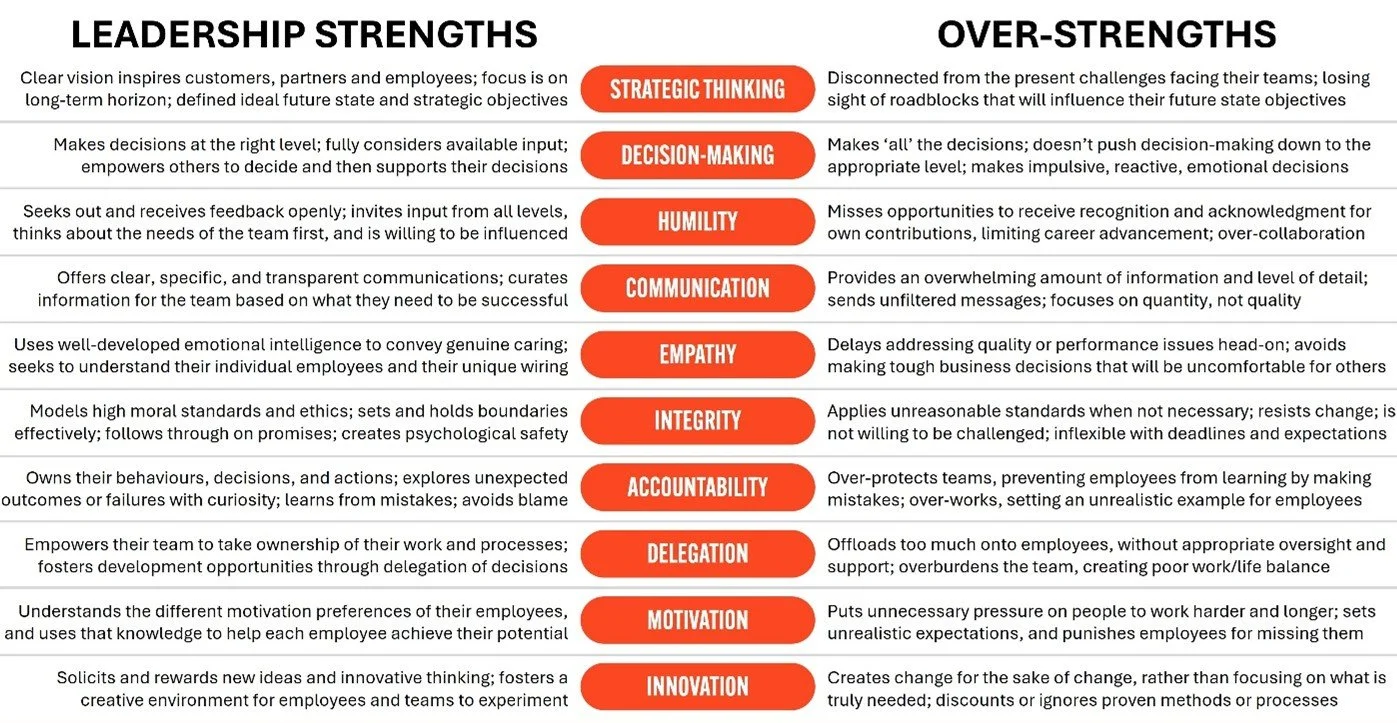Leslie Rohonczy, IMC™, PCC, Executive Coach, Leadership Expert, Speaker, Author
A senior leader walks into a team meeting (doesn’t that sound like the opening line to a joke!?), excited about his newly minted strategic vision, and confidently shares several decisions that he’s made. He offers a long list of ideas for reaction and execution, and he poses some powerful questions he wants answered. Each of these things is a quality leadership behaviour. So why does the room fall silent?
Chances are they’re not in awe; they’re overwhelmed.
This is a common occurrence in leadership, but it isn’t a villain story; it’s a visibility story – one that happens every day in organizations where well-intended leaders lean a little too far into their strengths. And the very qualities that earned them trust, promotions, and praise start to have the opposite effect.
This is the strength/over-strength paradox, and at its heart, it is a deceptively simple idea: a leadership strength, when overplayed, becomes a liability.
And yet, many leaders aren’t aware it’s happening until the damage is done. Why? Because they’re doing what’s always worked. Until it doesn’t.
WHY THIS MATTERS MORE THAN EVER
Trust in leadership is one of the strongest drivers of employee engagement and performance. And yet, in multiple global studies, more than half of employees say they don’t feel seen, heard, or understood by their leaders. That’s not just a gap – that’s a chasm! And in that chasm lurks the over-strength trap.
Think of your leadership as a soundboard in a recording studio. Every leadership attribute is an individual channel on the board:
strategic vision
decision-making
humility
communication
empathy
integrity
accountability
delegation
motivation
innovation
negotiation
change management
critical thinking
other (your unique leadership attributes)
When tuned just right, they create a harmonious mix. But push the fader too high on any one strength, and suddenly what was once inspiring becomes jarring. What was pleasing is now uncomfortable. What had been clear is now out of phase. And even though the other channels are set at the right volume, it can ruin the whole mix.
Let’s break it down using the graphic below, a snapshot of nine core leadership strengths (there are many others, some unique only to you!) Here’s what can happen when their volumes go unchecked.
STORIES FROM THE FRONT
Here’s where theory meets reality. These five short case studies are based on real coaching themes that have played out in boardrooms, team meetings, and one-on-ones. They showcase the human side of leadership; the moment where a well-meaning strength quietly shifts into overdrive, and the team dynamic shifts in response. If any of these stories feel familiar, you’re not alone – and you’re not off track. You’re just being invited to listen differently to your leadership ‘mix’, so you can make some adjustments, and tune your soundboard accordingly.
Case #1: The Strategic Visionary
Rajesh was known for his powerful strategic thinking. His colleagues described him as “the guy who could see around corners”. His head was typically five years ahead of the others on his team, who were still focused on Q1. His team was inspired... at first. But soon, they started feeling disconnected from the day-to-day realities. When asked what they needed to succeed, one team member quietly said, "I just need to know what I should be doing tomorrow." Rajesh had slipped into overstrength. His people felt abandoned in the present, trying to navigate the complexities on their own.
Case #2: The Empathetic Avoider
Marissa had developed a high level of emotional intelligence and compassion throughout her leadership career. Her people loved her warm personality; she was a great listener and genuinely seemed to care about them. She remembered birthdays, gave ‘free’ days off when they felt overwhelmed, and offered a soft shoulder to cry on when there was trouble at home. She also actively looked for developmental opportunities to offer each of her employees that would help them grow their careers. But when it came time to have hard conversations like missed deadlines, employee conflicts, or poor performance, she froze. Her empathy channel was so loud that it had drowned out her leadership accountability channel. She became avoidant, and slowly her team’s accountability eroded to the point that Marissa’s group developed a reputation for poor performance, which caused her top performers to look elsewhere, and made recruiting new employees difficult.
Case #3: The Humble Underdog
David was seen as a humble guy. He was always quick to credit his team for any successes and rarely took the spotlight. But over time, his unwillingness to take centre stage meant that he was invisible most of the time, which became a liability. Without the willingness to take up his full leadership space, the executive team couldn’t see his impact. David’s team, once proud of his modesty, started wondering if he lacked confidence in them – or in himself. It was an unnecessary distraction from the team’s mission and targets. Some became disengaged, while others tried to compensate by becoming more vocal (with uneven results). David’s humility had become an overstrength that muted his ability for bold influence, and his career stalled.
Case #4: The Delegating Ghost
Carla was an expert delegator. She understood delegation of authority thresholds and empowered her delegates to make decisions on her behalf and take action accordingly. She trusted her team and rarely micromanaged. But Carla wasn’t big on oversight. In fact, you could say she was allergic to it. Bored with mundane operational details, Carla preferred to live in the future, playing with strategic modelling and innovation trends. But without regular check-ins, guidance, and oversight, not only were projects veering off course and timelines slipping, but her people began to resent her, too. To her employees, Carla hadn’t delegated; she’d disappeared.
Case #5: The Motivational Machine
Jorge brought infectious energy to his leadership conversations. He was all about goal setting, giving recognition, and getting people fired up. His favourite expression was “push through”, something he often told employees when they raised concerns about their workload or capacity challenges. He was proud of how much his team could deliver, but as burnout crept in, his relentless positivity became exhausting. The team felt pressured to always perform at 110%, and some began hiding their struggles for fear of letting him down.
What once inspired them became a stress multiplier, and Jorge ended up with three employees on short-term stress leave.
All five of these leaders were doing what they thought was right. And they weren’t wrong. They just didn’t notice when their strengths started working against them.
BEST PRACTICES FOR BALANCING ACTS
So, how do you keep your soundboard balanced when the volume has crept up too high on one channel? How do you raise the volume on other channels to compensate? The following tips are some quick but powerful ways to ensure your leadership is landing the way you intend. These practices are grounded in real coaching tools and everyday leadership behaviours that can help you calibrate your leadership mix.
Make Feedback Normal, Not Formal
Build feedback into everyday conversation. The best leaders are curious, not just about ideas, outputs, metrics, and strategy, but about their own leadership impact. Ask: "What’s something I’m doing that’s getting in the way right now?"
Name Your Over-Strength
Introduce the strength/overstrength paradox concept to your team. Invite them to help you calibrate. It creates safety, builds trust, and diffuses the fear that giving feedback means they’re criticizing your character. Ask yourself: "Where might my team be seeing more of this strength than they need right now? What’s the unintended consequence I haven’t noticed yet?"
Coach the Strength Back to Centre
When a strength starts showing up too often or too intensely, it’s not about switching it off. It’s about adjusting the channel volume. Get back to the core purpose of the behaviour and check in on how it's being received. Ask yourself: "What’s the original intention here? What’s the ripple effect? What would ‘just enough’ look like?"
Use the 3-Point Leadership Lens
This quick tool helps leaders get out of autopilot and into alignment. Every time you lean on a strength, check:
is it aligned with the mission?
is it right for this moment?
is it working for the people?
What worked in the past may not land now, especially in times of change. Ask yourself: "Is this strength in service of the bigger picture – or is it just my default setting?"
Revisit Regularly
Strengths evolve. So should your leadership. Schedule quarterly self-check-ins, and invite an executive coach to help you explore your blind spots. Ask yourself: "What strengths have I been leaning on heavily this quarter? When I pause to consider whether they’re still fit for purpose, what do I notice?"
THE INVITATION
Leadership isn’t about turning every channel up to eleven. It’s about learning to engineer your soundboard. A little more clarity here, a little less volume there. Bringing in the bass line of strategy without drowning out the higher notes of empathy. The best leaders aren’t the loudest or smartest in the room. They’re the most attuned.
When your strength becomes someone else’s struggle – it’s time to rebalance. So here’s an opportunity to experiment: Be in relationship with your leadership strengths. Take the time to listen to each channel in relation to the other channels, and in relation to the overall mix. Notice what needs adjustment, what’s sitting just right in the mix, and what might need a gentle nudge back to centre.


